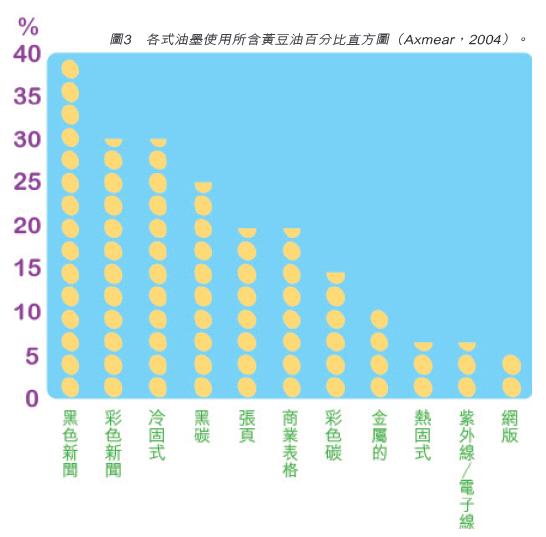(1) History Soybean ink was produced from the 1979 newspaper publishers association (the American Newspaper Publish Association, ANPA) and advocated the development of alternative petroleum-based printing inks. In order to reduce dependence on imported crude oil, it was discovered that Non-volatile and decomposable vegetable oils can produce vegetable inks instead of petroleum-based inks, which can improve the rub resistance of newspapers. In addition, the volatile organic compounds (VOCs) of petroleum-based inks cause ecological damage. Later, after more than 2,000 kinds of vegetable oils were tested by scholars, it was considered that soybean oil containing soybean oil was non-toxic and available. The chemical company started producing soy ink and later introduced it into the newspaper industry. (Wang Shouhong, 2004; Noirot, 2004; Axmear, 2004; Patterson, 2003). (b) Composition Soybean ink does not mean that the ink consists of 100% soybean oil. In fact, it only contains a small portion of soybean oil and still contains some petroleum derivatives. However, the Agricultural Research Service (ARS) in the United States has developed soybean ink containing 100% soybean oil and pigment. This new ink does not contain any petroleum or mineral oil, has high decomposability, and is well deinked. nature. U.S. Agricultural Research Department estimates that the future price of this type of ink will be lower than current inks. It may be because the 100% soybean ink uses more soy bean oil and less pigment, so the soy-oil extender can provide brighter colors. At present, this research and development has already applied for a patent (Morris, 1997). The following describes the composition and manufacturing process separately: 1. ingredients (1) Colorant The color is provided by pigments, which are organic and synthetic powders. Particles of the pigments that have been ground into the media are less than 0.1 micron, and the pigment component accounts for about 12-20% of the ink. (2) Vehicles It is mainly composed of hard resin, vegetable oil and some non-vegetative ingredients. Hard resin is mainly derived from pinetreerosin, which accounts for about 25% of ink and is a renewable resource. Vegetable oils, which consist of linseed oil or soybean oil, make up about 20% of India's ink. Some of the oils may not be used in their natural form. They may be prepolymerized, called alkyd resins. It can reach up to 80% of vegetable oil. The non-vegetative composition of ink is about 20 to 25%, which is called mineral oil and petroleum extracts. It is extracted from petroleum and belongs to non-reusable materials (Noirot, 2004). (3) Additives Like desiccants, antioxidants and waxes. 2. Manufacturing process There are three processes involved in producing soya bean inks, as well as manufacturing petroleum-based inks. The sequence is as follows (Patterson, 2003): (1) The medium must first be boiled. Here is the soybean oil that carries the pigment, and then add some dyes to stir. (2) Then use a roller to grind the pigment to the medium. (3) In the end, the moisture in the wet pigment sludge must be removed by the ink medium. (4) The modulation of the final ink varies depending on the requirements of the substrate and the printing method. Third, the application of soybean ink in printing Soybean inks are mainly used in lithographic printing, including newsprint, books and magazines. They can also be used in packaging printing, business forms or other commercial printing applications. Soybean ink In printing applications, ink manufacturers must respond to different types of printing methods, oil content is also different, Figure 3 (A xmear, 2004) is a histogram of the percentage of soybean oil in all types of ink. Since Soybean Ink has successfully entered the newspaper printing industry, it also considers other printing applications. The following is a brief description. (a) sheet-fed ink Sheet-fed inks use linseed oil as a component of printing inks for many years and use linseed oil because it gives the ink good flow properties, but drying takes a long time. The most popular vegetable oil is linseed oil because its drying is faster than soybean oil or safflower oil and its ink film is harder. In order to speed up the drying process, it is usually necessary to add additives such as manganese. Sheet-fed inks are generally dried by oxidative polymerization and used in relatively small printers such as commercial printers, and are usually printed once on a sheet of coated or uncoated paper. This type of ink contains more resin than news ink and needs to be dried faster than rotary printing when printing coated paper. Soybean ink usually contains 20-30% of soybean oil, but still contains at least 10% of mineral oil (Chen Zhonghui, 2000; Simpson, Tazik, Miller & Randall, 1994; Patterson, 2003; Kohler's cornersoyink article, 2005). (B) Rotary ink (web ink) 1. Heat-set ink Thermosetting inks are usually dried by heating. Many rotary presses use large paper rolls to publish magazines. This type of printed paper is usually coated and absorbs less oil in the ink. To solve this problem, the paper was then passed through a high temperature oven to fix the ink on the paper. Therefore, the liquid composition of such a thermosetting ink must be easily evaporated to form a thermosetting type of drying. However, vegetable oils do not evaporate and may not be useful in thermosetting drying because the prints must be dried after passing through a chill roll. If the drying takes several hours due to oxidation, they cannot be characterized by the oxidative drying of vegetable oils. The use of resin made from 10% of vegetable oil added to the ink to dry it has been achieved using linseed oil for many years. However, after testing soybean oil and other vegetable oils, the ink was found to be hard to harden, so it was learned that Soybean oil and other vegetable oils are not easily evaporated, so they are not suitable for replacing volatile components in thermosetting inks. Nowadays, manufacturers have gradually replaced soybean oil with sesame oil as the varnishes of thermosetting inks. Generally, this type of soybean ink requires at least 7% of soybean oil (Patterson, 2003; Chen Zhonghui, 2000; Kohler's). Scorner- soy ink article, 2005). 2. Cold-set ink Press ink is the easiest to combine with soybean oil, because the drying properties of the lithographic ink are actually absorbed by the ink and penetrate into the pores of the matrix, and can be quickly absorbed and dried, or dried using an oxidizing method. The ink ink here is low viscosity. The standard adhesive for black press printing is a solution obtained from high oxidized bitumen or natural bitumen dissolved in high-boiling mineral oils. In the same way, asphalt may also be dissolved in vegetable oils such as soybean oil. However, the adhesive thus completed does not seem to provide technical advantages over the mineral oil adhesive. Absorptive papers such as newspaper clippings, catalogues, and telephone directories are usually cold-curable inks, so this type of ink usually contains at least 30% of soybean oil (Chen Zhonghui, 2000; Patterson, 2003; Kohler's Corner-soy inkarticle, 2005). (C) business forms ink (business forms ink) When this type of ink is used in a printer, it is usually a long roll of unprinted paper on a printed form. This type of ink contains at least 20% of soybean oil. Since soy oil does not evaporate when the soy ink is dried, it polymerizes when the ink hardens, and is therefore disadvantageous in a large number of commercial prints (Patterson, 2003; http://, 1997). (d) Flexographic inks This kind of elastic letterpress ink is a water-based or solvent-based ink, does not contain vegetable oil components such as soybean oil, but contains plant protein (soy bean protein), which can make pigments adhere to the paper to complete printing, usually the soybean protein content is 15 ~20% (Patterson, 2003). (e) Others - Industrial Coatings For many years, soybean oil was mainly used to make alkyd, which was dissolved in a carrier solvent to make oily pigments. However, in the production of alkyd resins and the preparation of pigments and coatings, the basic chemistry of soy oil must be converted to heat and pressure before it can be converted into alkyds. At the same time, powder coatings and thermosetting coatings have been added for industrial coatings, gradually replacing liquid alkyd pigments. Most of these new coatings are dried by heat, electron light, ultraviolet light, and the like, and are dried by input energy (Soy-base paint and Coatings Technical Fact Sheet, 2003; Hackmann, 2002).
We have so many materials to make Outdoor Banners ,
such as Vinyl Banners , PVC Banners , Canvas Banners , tarpaulin banners , PE
banners . The printing tech is large format inkjet printing . The width
seamless is 500cm ( 16.4 feet ) and length is 30 - 50 meters .The quality
guarantee is one year outside . If using our uv printing tech ,the quality is 3
– 5 years outside .The ink is uv imported from Italy . It prints with 1440 *
1440 dpi to make the color very vivid and stereo perception .
We provide strong hemmed edge for all of our outdoor
banners to make them much durable .
Finishing :
Folded edge with grommets
Sewing edge with copper grommets



Custom Banners,Custom Banners Printing,Advertising Custom Banners,Printed Custom Banners
Golden Mouth Advertising (H.K)Co.,Ltd. ( Jie Da Advertisement Co.,Ltd) , http://www.advertisingflagbanners.com